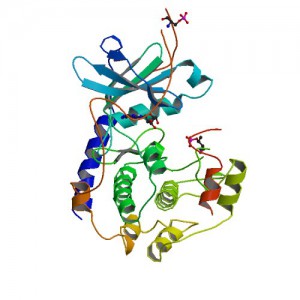
Researchers often need to purify a single protein for further study. One method for isolating a specific protein is the use of affinity tags. Affinity purification tags can be fused to any recombinant protein of interest, allowing fast and easy purification following a procedure that is based on the affinity properties of the tag.
The most commonly used tag to purify and detect recombinant expressed proteins is the polyhistidine tag. Protein purification using polyhistidine tags relies on the affinity of histidine residues for immobilized metal such as nickel, which allows selective protein purification. The metal is immobilized to a support through complex formation with a chelate that is covalently attached to the support.
Polyhistidine tags offer several advantages for protein purification. The small size of the polyhistidine tag renders it less immunogenic than other larger tags. Therefore, the tag usually does not need to be removed for downstream applications following purification.
A large number of commercial expression vectors that contain polyhistidine are available. The polyhistidine tag may be placed on either the N- or C-terminus of the protein of interest.
And finally, the interaction of the polyhistidine tag with the metal does not depend on the tertiary structure of the tag, making it possible to purify otherwise insoluble proteins using denaturing conditions. The resulting purified protein can be used for a variety of applications.
The following references illustrate examples of some of the most common post purification applications with fusion proteins containing a polyhistidine tag:
Enzymatic assays
- Negi, V-S. et al. (2014) A carbon nitrogen Lyase from Leucaena leucocephala catalyzes the first Step of mimosine degradation. Plant Physiol. 164, 922–34.
- Yu, S. et al. (2013) Syk Inhibits the activity of protein kinase A by phosphorylation tyrosine of the catalytic subunit. J. Biol. Chem. 288, 10870-81.
- Rusconi, B. et al. (2013) Discovery of catalases in members of the Chiamydiales order. J. Bact. 195, 3543–51.
Structural analysis
- Araiso, Y. et al. (2014) Crystal structure of Saccharomyces cerevisiae mitochondrial GatFAB a novel subunit assembly in tRNA –dependent amidotransferases. Nucl.Acids. Res.(available only online).
- Someya, T. et al. (2012) Crystal Structure of Hfq from Bacillus subtilis in complex with SELEX-dervived RNA aptamer: insight into RNA-binding properties of bacterial Hfq. Nucl. Acid Res. 40, 1856-67.
Protein pulldowns
- Yun, S-C. et al. (2010) Pmr a Histone-like protein H1 (H-NS) family protein encoded by the IncP-7 plasmid pCAR1, is a key global regulator that alters host function. J.Bact. 192, 4720–31.
- Haim, H. et al. (2010) Cytokeratin 8 interacts with clumping factor B: a new possible virulence factor target. Microbiology 156, 3710-21.
Additional Resources
His-tagged Protein Purification Systems
